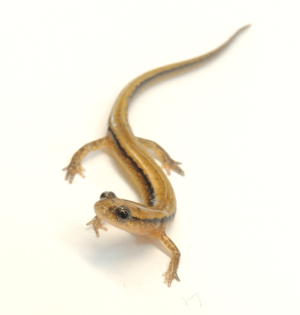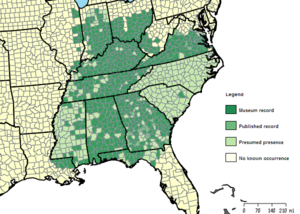Southern two-lined salamander facts for kids
Quick facts for kids Southern two-lined salamander |
|
|---|---|
 |
|
| Conservation status | |
| Scientific classification |
The southern two-lined salamander (Eurycea cirrigera) is a small, slender type of salamander. It belongs to the Plethodontidae family, which are lungless salamanders. This salamander is found only in the United States, meaning it is endemic there.
These salamanders live in cool, wet places. Their natural habitats include temperate forests, rivers, and swamps. They also like freshwater springs and rivers that sometimes dry up.
Contents
What Does It Look Like?
The southern two-lined salamander is a small and thin creature. It is easy to spot because of two dark lines running along each side of its body. The salamander's skin is usually a deep or light brown color.
It grows to be about 6.5 to 12 centimeters (2.5 to 4.7 inches) long. This species has 14 grooves, called costal grooves, between its front and back legs. These grooves help it move and breathe.
A key way to tell the southern two-lined salamander apart from the Northern two-lined salamander is how far its black lines go. For the southern species, these lines go all the way down to its tail.
When male salamanders become adults, they develop small bumps called cirri near their noses. Their jaw muscles also get bigger.
Different Types of Southern Two-Lined Salamanders
The southern two-lined salamander used to have two main forms, or morphs. One of these, the Brownback salamander, is now considered its own separate species.
The other form is called the Cole Springs Phenotype. This type is found in other two-lined salamanders, but for the southern two-lined salamander, it is only seen in northern Alabama. Salamanders with the Cole Springs phenotype are much larger and darker than the usual southern two-lined salamanders.
Where Does It Live?
The southern two-lined salamander is found across the Southeast United States. However, you will not find it in the Florida peninsula.
Keeping Them Safe
Scientists have noticed that as areas around rivers and streams become more developed with buildings and roads, these places become less suitable for southern two-lined salamanders to live.
Even though this species is not currently in danger of disappearing, experts suggest creating special protected areas along streams. These "unbreached buffers" would help keep the salamander's habitat safe and healthy.



